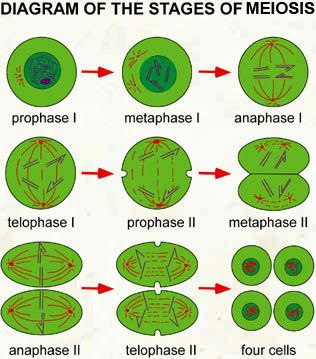Meiosis is a two part cell division process that occurs in organisms that sexually reproduce. The meiotic process produces gametes with one half of the number of chromosomes as the parent cell. There are two stages in meiosis. They are known as meiosis I and II. At the end of it all, there are four daughter cells that are produced as a result. Each of the daughter cells have one half of the number of chromosomes as the parent cell.
Meiosis I
Meiosis I has two main purposes: It reduces the number of chromosomes in half, which makes the daughter cells haploid since the parent cells were diploids. Also, it is during this process in which most of the genetic recombination happens.
Phases:
Prophase: This is very similar to the process that occurs in mitosis. During prophase, the DNA condenses and the nucleare envelope along with the nucleoli disappear. This is when the spindle starts to form. As DNA condensation continues, the chromosomes become visible as tetrads.
Metaphase: The tetrads line up in the center and the spindle have completely formed.
Anaphase: The tetrads pull apart and chromosomes with two chromatids move towards the opposite poles.
Telophase: Chromosomes that have two chromatids will become un-condensed and a nuclear envelope will reform around them. Each nucleus is a haploid.
Meiosis II
When meiosis I is finished, each of the chromosomes has 2 chromatids. This is double the amount of DNA the cell should contain. So the cells undergo meiosis II in order to reduce the amount of DNA to a normal amount. The chromosomes will split so that each daughter cell will only have one chromatid per chromosome.
Phases:
Prophase II: The chromosomes with two chromatids become seen as they condense, the envelope and nucleoli disappear, and the spindle forms
Metaphase II: The chromosomes line up in the middle and the spindle is completely formed.
Anaphase II: The chromosomes split, leaving behind chromosomes with only a chromatid that is going towards opposites sides.
Telophase II: Chromosomes that only have one chromatid redistribute and are surrounded by nuclear envelopes again. The 4 daughter cells that are formed are all haploid and have correct amounts of DNA. They can now be developed into sperm or eggs.


No comments:
Post a Comment